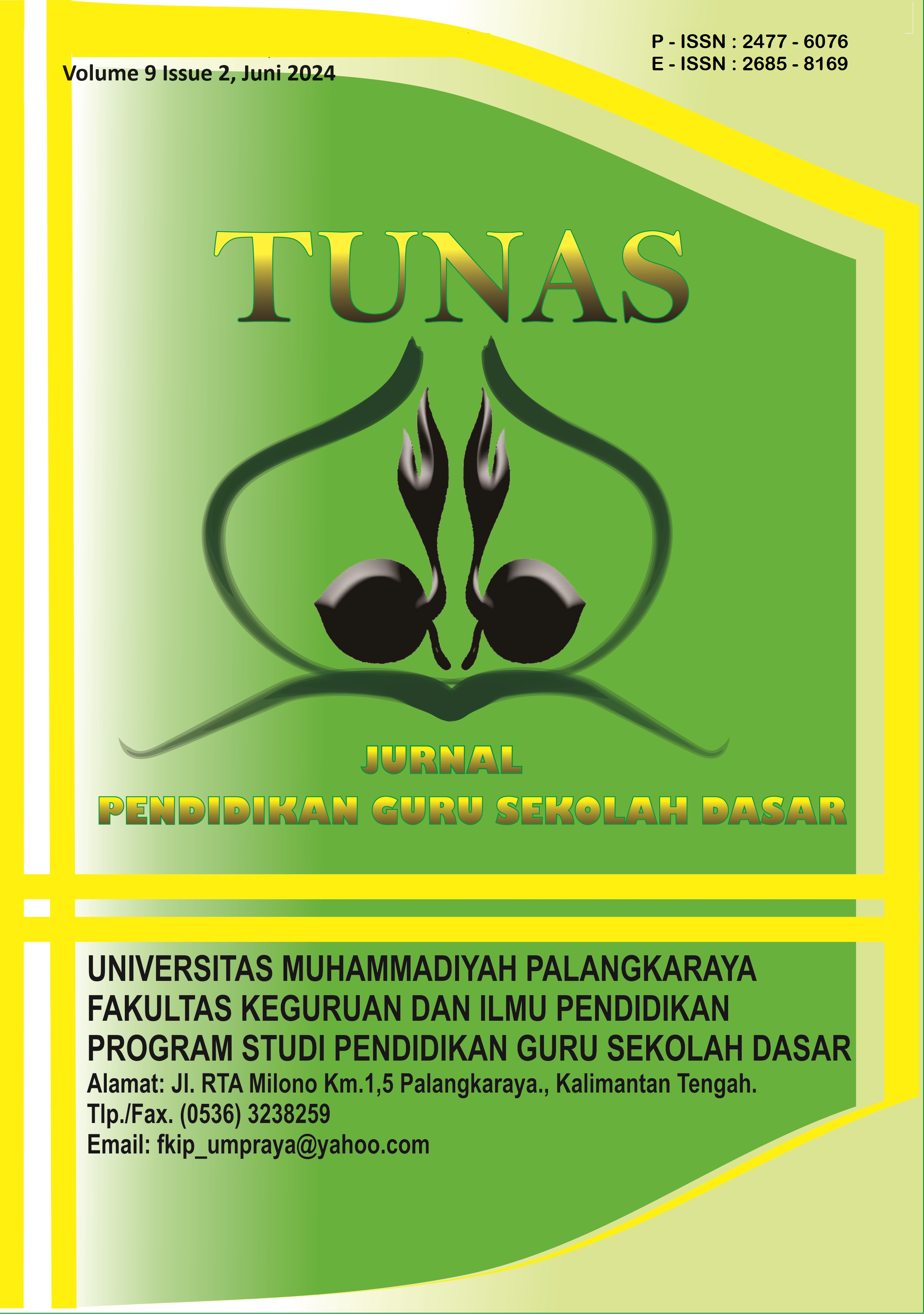The Value of Folklore Characters in Literacy Reading Materials in Elementary School
Main Article Content
Abstract
Instilling character values in the present is very necessary to overcome the moral crisis, especially in the phase of children and adolescents. This research was conducted so that teachers can know the character values contained in folklore and can use folklore as a learning medium that will be used during literacy learning in elementary schools. The approach used in this study is qualitative descriptive research method. Research methods that contain data quotations to give an overview of the presentation of research. The type of research used is library research. The source of data in this study is South Kalimantan Folklore and Nusantara Folklore published by Pustaka Sandrojaya. The data collection techniques used are literature study techniques and text observation techniques. The results showed that character values in the folklore of South Kalimantan and Nusantara found seven character values. The seven character values are 1) The character value of friendship that can be found in the folklore entitled Magic Crocodile and Suri Ikun, 2) The value of hard work character that can be found in the folklore entitled Pangeran Samudera, Putri Junjung Buih, The Story of Nini Kudampai and Si Angui, Galuh Rumbayan Amas, Malin Kundang and Timun Emas, 3) The value of social care characters that can be found in the folklore entitled Pangeran Samudera, Putri Junjung Buih, Putri Niwer Gading, Ular n'Daung, Suri Ikun and Si Putri Malam, 4) The value of environmentally caring characters that can be found in folklore entitled Asal MulaTelaga Biru and Buaya Ajaib, 5) The character value of responsibility that can be found in folklore entitled Pangeran Samudera dan Putri Junjung Buih, 6) The value of discipline character that can be found in the folklore entitled Putri Junjung Buih, and 7) The value of the curious character that can be found in the folktale entitled The Princess of the Night. Based on the character values found, the value of socially caring characters is the most common value found in folklore.
Downloads
Article Details

This work is licensed under a Creative Commons Attribution-ShareAlike 4.0 International License.
Authors who publish with this journal agree to the following terms:
- Any article on the copyright is retained by the author(s).
- The author grants the journal, right of first publication with the work simultaneously licensed under a Creative Commons Attribution License that allows others to share work with an acknowledgment of the work authors and initial publications in this journal.
- Authors are able to enter into separate, additional contractual arrangements for the non-exclusive distribution of published articles of work (eg, post-institutional repository) or publish it in a book, with acknowledgment of its initial publication in this journal.
- Authors are permitted and encouraged to post their work online (e.g., in institutional repositories or on their websites) prior to and during the submission process, as can lead to productive exchanges, as well as earlier and greater citation of published work.
- The article and any associated published material is distributed under the Creative Commons Attribution-ShareAlike 4.0 International License
References
Abidinsyah, Lagiono, Ria Mayasari, Lili Agustina, Irni Cahyani, & Maryam Agustina. (2022). SOSIALISASI GERAKAN LITERASI MEMBACA PESERTA DIDIK SDN SEBERANG MESJID 1 BANJARMASIN. Batuah: Jurnal Pengabdian Kepada Masyarakat, 2(2), 68-76. https://doi.org/10.33654/batuah.v2i2.1945
Agustina, Lili. (2017). Analisis semiotik dalam kumpulan cerpen Air mata ibuku dalam semangkuk sup ayam. Stilistika: Jurnal Bahasa, Sastra dan Pengajarannya. Vol. 2 No. 1 2017
Agustina, L., Dodiet Enggar Wibowo, & Irni Cahyani. (2023). SOSIALISASI DAN PELATIHAN ASESMEN PADA KURIKULUM MERDEKA SDN 3 SUNGAI ULIN BANJARBARU. Batuah: Jurnal Pengabdian Kepada Masyarakat, 3(2), 71-77. https://doi.org/10.33654/batuah.v3i2.2489
Fitriawati, F., & Agustina, L. (2021). Kearifan Lokal Dalam ”1001 Peribahasa Banjar Pilihan” Karya Aliansyah Jumbawuya . Lentera: Jurnal Ilmiah Kependidikan, 16(2), 1 - 13. https://doi.org/10.33654/jpl.v16i2.1500
Kuzairi, Hidya Maulida, Norliani, Lili Agustina, Desi Hidayanti, & I Made Darmayasa Wilantara. (2021). BELAJAR BERCERITA MELALUI PUPPET BOOK BERSAMA ANAK-ANAK GRIYA YATIM & DHUAFA MENTAOS BERBAGI BANJARBARU. Batuah: Jurnal Pengabdian Kepada Masyarakat, 1(1), 21-30. https://doi.org/10.33654/batuah.v1i1.1339
Luthfiyanti, Lita, dkk. (2019). Pendidikan karakter dalam buku banjar negeri harum 1001 gurindam karya haji iberamsyah barbary. Stilistika: Jurnal Bahasa, Sastra dan Pengajarannya. (4) 1 April 2019
Hendriana, Cinda Evinna & Arnold Jacobus. (2016). Impelementasi Pendidikan Karakter di Sekolah melalui Keteladanan dan Pembiasaan. Jurnal Pendidikan Dasar Indonesia. Vol 1 (2) 2016.
Hidayah, Nurul. 2015. Penanaman Nilai-Nilai Karakter Dalam Pembelajaran Bahasa Indonesia di Sekolah Dasar. Jurnal Pendidikan dan Pembelajaran Dasar. Vol 2. (2) 2015.
Junaini, Esma, dkk. 2017. Analisis Nilai Pendidikan Karakter dalam Cerita Rakyat Seluma. Jurnal Korpus. Vol 1 (1) 2017
Masnur, Muslich. dan Gusti Ngurah Oka. 2011. Pendidikan Karakter. Menjawab Tantangan Krisis Multidimensi. Bumi Aksara. Jakarta.
M.Lutfiannor, Hidya Maulida, & Lili Agustina. (2023). NILAI KARAKTER PADA CERPEN BUKU TEMATIK KELAS IV SEKOLAH DASAR . Prosiding Seminar Nasional Bahasa, Sastra, Seni, Dan Pendidikan Dasar (SENSASEDA), 3, 109-114. Retrieved from https://mathdidactic.stkipbjm.ac.id/index.php/sensaseda/article/view/2607
Mustari, Mohammad. 2014. Nilai Karakter: Refleksi untuk Pendidikan. Jakarta: Rajawali Pers.
Penyusun. 2016. Panduan Gerakan Literasi Sekolah di Sekolah Dasar. Jakarta: Direktorat Jenderal Pendidikan Dasar dan Menengah, Kementerian Pendidikan dan Kebuadayaan.
Sumayana, Yena. 2017. Pembelajaran Sastra di Sekolah Dasar Berbasis Kearifan Lokal (Cerita Rakyat). Mimbar Sekolah Dasar Vol. 4 (1) 2017.
Tsauri, Sofyan. 2015. Pendidikan Karakter: Peluang dalam Membangun Karakter Bangsa. Jember: IAIN Jembeer Press.
Wulandari, N. I., Winda, N., & Agustina, L. . (2022). INTERAKSI SOSIAL DALAM NOVEL ANAK RANTAU KARYA A. FUADI. Jurnal Basataka (JBT), 5(2), 340–348. https://doi.org/10.36277/basataka.v5i2.166
Zubaedi, 2011. Desain Pendidikan Karakter. Jakarta: Kencana.
